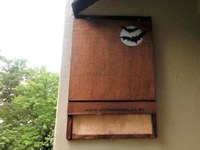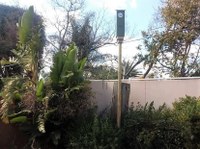Bat Boxes
EcoSolutions manufactures different designs of bat houses. The Slimline bat house (home for up to 100 bats) is installed against the side of your house on a wall that receives afternoon sun and the Nursery and Rocket bat hotel (home for up to 300 bats) which is easy to mount on a gum pole in full sun.



Bats are super little critters and often wrongly vilified: they keep the mosquito population nicely under control and complement your garden wildlife perfectly. They are unobtrusive and not harmful to you or your domestic pets and, contrary to popular belief, have no interest in getting entangled in your hair.
Encouraging bats is also the very best way of getting rid of those pesky mozzies! A single bat house may become home to 100 or so bats, which will consume up to 60,000 insects a night.
Bats are a sort of ‘bug police’: they fly around and catch insects using a process called echolocation to find their insect meals. They make high-pitched sounds that bounce off objects and return to the bat as echoes. Bats in flight can distinguish the difference in sound between a tree, your head, and a mosquito! They reduce pests naturally, reducing the need for pesticide usage and thereby helping to make our water and earth cleaner.
About 70 percent of all bats eat insects: flies, mosquitoes, beetles, and cockroaches. Bats are also responsible for pollinating trees, flowers, and cacti. They spread seeds so plants grow in new areas. Bats pollinate avocados, bananas, breadfruit, dates, figs, mangoes, and peaches. These remarkable mammals live in sophisticated colonies and each can eat half its weight in insects a night, so they are great at controlling large numbers of pests that harm crops and spread disease. Certain microorganisms found in bat droppings may have important medical uses for humans!

